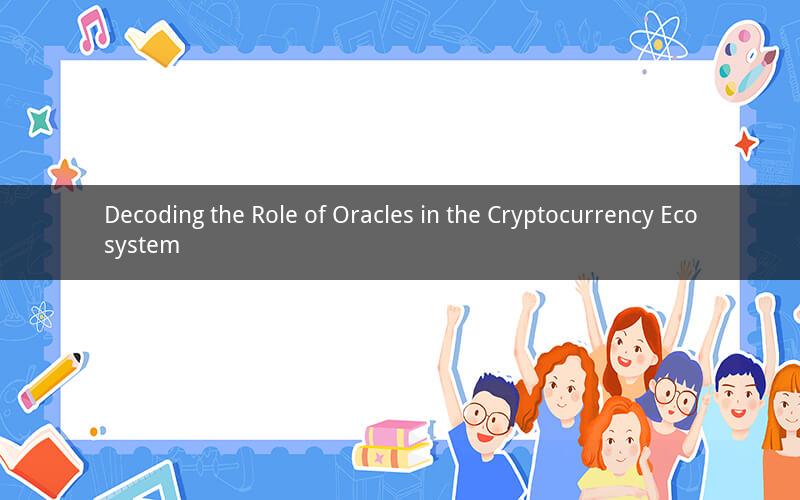
In the ever-evolving world of cryptocurrencies, oracles have emerged as pivotal components that bridge the gap between the digital and physical worlds. These entities serve as reliable sources of information, enabling smart contracts to execute complex operations based on real-world data. This article delves into the concept of oracles in crypto, exploring their significance, types, and the challenges they face.
What are Oracles in Crypto?
Oracles are intermediaries that provide data to blockchain networks, allowing smart contracts to interact with external information. They act as a bridge between the immutable and transparent blockchain environment and the unpredictable and complex real-world. By doing so, oracles enable smart contracts to execute conditional transactions, automate processes, and facilitate a wide range of applications.
The Importance of Oracles in Crypto
1. Facilitating Real-World Interactions: Oracles enable smart contracts to interact with real-world data, such as stock prices, weather conditions, or election results. This opens up possibilities for creating decentralized applications (DApps) that can automate various processes and reduce the need for intermediaries.
2. Enhancing Security: By providing accurate and reliable data, oracles enhance the security of smart contracts. Since smart contracts are based on predefined rules, the accuracy of the data they rely on is crucial. Oracles help mitigate the risk of fraudulent or manipulated data.
3. Reducing Transaction Costs: Oracles can reduce transaction costs by eliminating the need for intermediaries. In traditional financial systems, intermediaries such as banks, brokers, and exchanges charge fees for their services. Oracles can streamline these processes, leading to lower costs for users.
Types of Oracles
1. Blockchain Oracles: These oracles rely on blockchain technology to ensure the integrity and transparency of the data they provide. They often use consensus mechanisms, such as Proof of Work (PoW) or Proof of Stake (PoS), to validate data sources.
2. Software Oracles: Software oracles gather data from various sources, such as APIs, web services, or databases. They then process and transmit this data to blockchain networks. Examples include Chainlink and Augur.
3. Hardware Oracles: Hardware oracles rely on physical devices to collect and transmit data. They are commonly used in applications involving IoT (Internet of Things) devices, such as smart cities or supply chain management.
4. Decentralized Oracles: These oracles use a decentralized network of nodes to validate and transmit data. This approach enhances security and reduces the risk of manipulation. Examples include Band Protocol and Aragon.
Challenges Faced by Oracles
1. Data Accuracy: Ensuring the accuracy of the data provided by oracles is a significant challenge. Since oracles rely on external sources, there is always a risk of data manipulation or incorrect information.
2. Scalability: As the number of oracles and smart contracts increases, ensuring scalability becomes a crucial issue. Oracles must be able to handle a large volume of data and transactions without compromising their performance.
3. Security: Oracles are vulnerable to attacks, such as Sybil attacks, where an attacker can manipulate the data by creating multiple nodes. Ensuring the security of the oracle network is essential to maintain the integrity of blockchain applications.
4. Legal and Regulatory Issues: Oracles may face legal and regulatory challenges, especially when dealing with sensitive data or interacting with traditional financial systems.
Frequently Asked Questions (FAQs)
1. What is the main purpose of an oracle in the cryptocurrency ecosystem?
Answer: The primary purpose of an oracle is to provide real-world data to blockchain networks, enabling smart contracts to interact with external information.
2. How do oracles ensure the accuracy of the data they provide?
Answer: Oracles use various methods, such as consensus mechanisms, third-party data sources, and decentralized networks, to ensure the accuracy of the data they provide.
3. What are the most common types of oracles?
Answer: The most common types of oracles are blockchain oracles, software oracles, hardware oracles, and decentralized oracles.
4. What are the main challenges faced by oracles?
Answer: The main challenges faced by oracles include ensuring data accuracy, scalability, security, and dealing with legal and regulatory issues.
5. How do oracles contribute to the development of decentralized applications (DApps)?
Answer: Oracles enable DApps to interact with real-world data, allowing them to automate processes, reduce transaction costs, and enhance security. This opens up new possibilities for creating innovative applications in various industries.